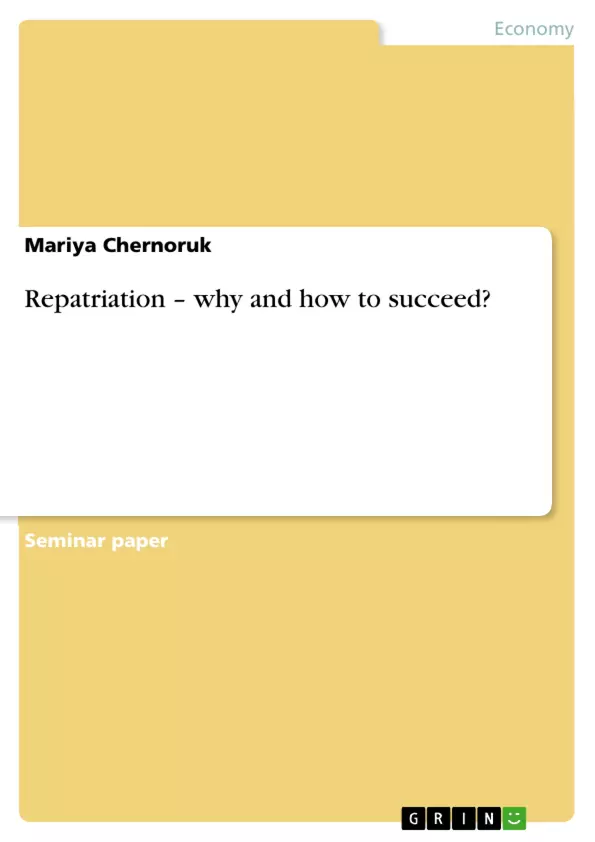Against the background of global activities, Multinational Companies (MNC’s) increasingly send managers and executives abroad, to work on their management skills and promote their knowledge of business across national borders (Halpern, 2005). The results of ECA International research (2008) have shown that 63% of MNC’s are planning to extend their international delegations and underline the importance of international assignments.
Within implementation of international assignments, repatriation shows the largest potential for improvement in current practice (Keller, 2001). Human resource managers mainly focus on the pre-departure phase and activities during the assignment. According to a survey conducted by Matthews (2007), only 4% of personal managers report on re-entry strategies, while 21% do not worry about the reintegration process. Although 70% of 100 MNC‘s state to offer a formal re-entry policy, more than 50% have no evaluation of repatriate overseas-experience (Stahl, Mayrhofer & Kühlmann, 2005).
As result, remarkably 30% of repatriates in German-based MNC’s leave their company within the first year after their return (Siebeke, 2009). Hence, despite thorough selection, preparation of candidates and great expense, many MNC’s fail to capitalize on their human investments (Halpern, 2005).
This paper concentrates on measures for creation of a successful repatriation. A short discussion of re-entry difficulties in the current practice and their theoretical background will be followed by a description of impact on MNCs caused by insufficient repatriation. Furthermore, some measures will be introduced to facilitate the repatriation especially by creation of a win-win situation.
Inhaltsverzeichnis (Table of Contents)
- Introduction
- Insufficient Re-entry and its Effects
- Re-entry in the current practice
- Person-Environment Fit Model
- Impact of insufficient repatriation on MNC
- Creating a successful Repatriation
- Measures to facilitate the re-entry
- Before assignment
- During assignment
- After return
- Win-Win Situation
- Measures to facilitate the re-entry
- Conclusion
Zielsetzung und Themenschwerpunkte (Objectives and Key Themes)
This paper aims to analyze the challenges and opportunities of repatriation for multinational companies (MNCs). It investigates the reasons why successful repatriation is crucial for companies and the consequences of insufficient re-entry strategies. The paper delves into the theoretical underpinnings of repatriation, particularly exploring the Person-Environment Fit Model and its implications for successful reintegration. Finally, it proposes practical measures to create a win-win situation for both the company and the repatriate, ultimately fostering a smooth transition back to the home country.
- The importance of successful repatriation for MNCs
- The impact of insufficient repatriation on employee performance and company success
- The role of the Person-Environment Fit Model in understanding re-entry challenges
- Practical strategies for facilitating successful repatriation
- Creating a win-win situation for both repatriates and their companies
Zusammenfassung der Kapitel (Chapter Summaries)
- Introduction: This chapter provides a brief overview of the growing trend of international assignments and the importance of repatriation within the context of global business operations. It highlights the lack of focus on repatriation strategies in current practice and the significant financial and human capital losses resulting from ineffective reintegration processes.
- Insufficient Re-entry and its Effects: This chapter explores the complexities of re-entry from the perspective of both the company and the repatriate. It discusses the common challenges faced by returning employees, including career anxiety, work adjustment, social integration, and the potential for re-entry shock. The chapter further examines the Person-Environment Fit Model, a theoretical framework used to understand the stress factors involved in the reintegration process.1
- Creating a successful Repatriation: This chapter presents a comprehensive approach to creating successful repatriation strategies. It outlines key measures that can be implemented before, during, and after the international assignment to facilitate a smooth transition back to the home country. These measures aim to address both career and personal needs, ensuring a positive and rewarding experience for the repatriate.
Schlüsselwörter (Keywords)
The paper focuses on the key topics of international assignment, repatriation, re-entry shock, Person-Environment Fit Model, MNCs, human resource management, and win-win situation. These themes are central to understanding the challenges and opportunities associated with successful reintegration after international assignments.
- Quote paper
- Mariya Chernoruk (Author), 2011, Repatriation – why and how to succeed?, Munich, GRIN Verlag, https://www.grin.com/document/167009



